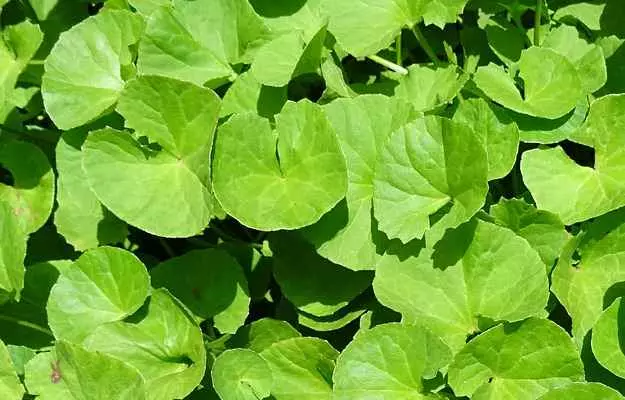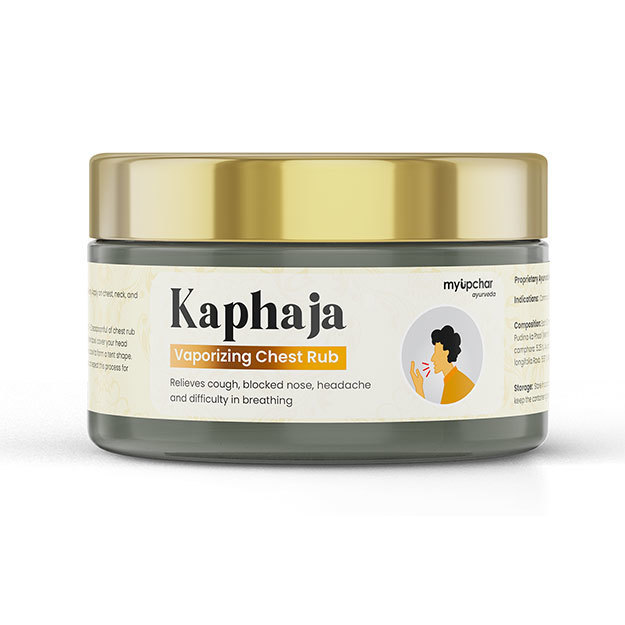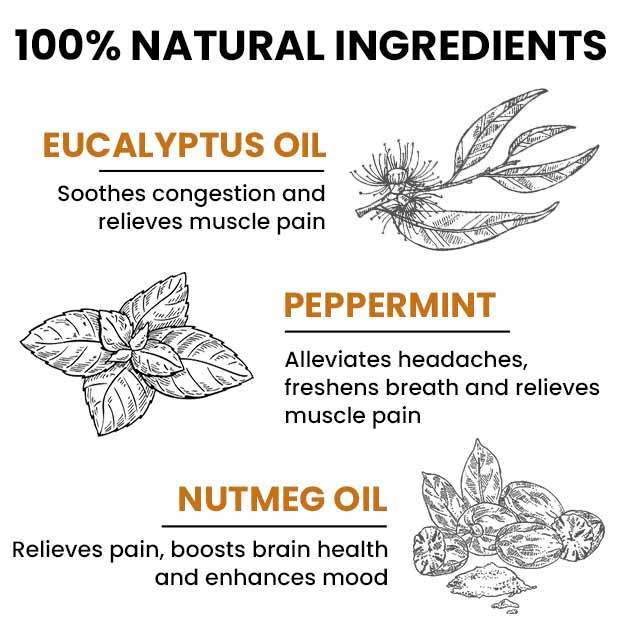Brahmi is an ancient Indian herb, famously known for its benefits in healing the nervous system and improving brain function. Ayurvedic medicine titles it as a medhyarasayana, which means, it acts as a nerve tonic and a revitalizing agent. Although it has quickly come to the mainstream as an adaptogenic agent, brahmi has been in use by Indian traditional medicine for about 3000 years. Mentions of this herb have been found in two of the most ancient Indian texts Charak Samhita and Sushruta Samhita. Sushruta Samhita talks about the use of brahmi ghrita and brahmi as a rejuvenator.
It might interest you to know that the word brahmi comes from the word Brahman or the name of the Hindu God Brahma, both of these refer to the universal mind or consciousness. So, brahmi literally means the power of Brahma. It might also refer to the tonic effects of brahmi on the nervous system.
Brahmi plant is a creeping succulent. It primarily spreads on the ground and has a tendency to retain a lot of water. It is a perennial herb (doesn’t need replanting) and grows well in wetlands and marshy areas. The succulent leaves of brahmi plant grow opposite to each other on its branches. Brahmi bears white, blue and purple coloured flowers which grow solitary on the ends of the branches.
Some basic facts about brahmi:
- Botanical name: Bacopa monnieri
- Family: Plantaginaceae
- Common name: Brahmi, jalbuti, water hyssop, moneywort, Indian pennywort
- Sanskrit name: Brahmi
- Parts used: Leaves, stem
- Native region and geographical distribution: Brahmi is primarily found in the tropical and subtropical regions of the world. It grows well in India, Nepal, Pakistan, China, and Sri Lanka. In India, brahmi can be found in the states of Punjab, Rajasthan, Bihar, Delhi, Goa, Tamil Nadu, West Bengal, and Kerala. Brahmi has also been reported growing in many Arabian countries including Yemen, Saudi Arabia, and Kuwait.
- Energetics: Cooling
-
Brahmi health benefits
- Brahmi for cognition and memory
- Brahmi for stress and anxiety
- Brahmi for depression
- Brahmi for epilepsy
- Brahmi for Alzheimer's
- Brahmi as an antioxidant
- Brahmi as an anti-inflammatory
- Brahmi relieves pain
- Brahmi benefits for stomach
- Brahmi as an antimicrobial
- Brahmi benefits for hair
- Brahmi for diabetes
- Ways to use brahmi
- Brahmi dosage
- Brahmi side effects
Brahmi health benefits
Brahmi has a lot of health benefits for the body but most of them are related to a direct or indirect action on the nervous system. In fact, the most important use of brahmi is in the form of a nerve tonic. Let's explore some of the healing benefits of brahmi:
- For the brain: The most significant benefit of brahmi has been found to be on the brain. It helps to enhance memory and cognition and can thus be used for students. It also helps in improving brain functioning in individuals affected with conditions like dementia and schizophrenia. One of its most pronounced applications has been in the management of Alzheimer’s disease, in which it significantly helped to reduce the symptoms. Further, it helps to reduce stress and anxiety and can be useful for individuals suffering from depression.
- For epilepsy: An extension to its benefits on the brain, brahmi may also be helpful in the treatment of seizures by having an anticonvulsant action.
- For the hair: Brahmi is helpful in promoting the growth of hair and avoidance of scalp infections.
- For diabetes: The use of brahmi may have a hypoglycemic (blood sugar lowering) effect as it helps to reduce diabetic complications.
- Other benefits: Brahmi has an antioxidant effect, which is responsible for its neuroprotective actions. It is also an anti-inflammatory and its use has further been suggested as a pain killer. Certain active compounds of the herb also establish its antimicrobial effect, which may be effective against H. pylori, which is responsible for gastric ulcers.
Brahmi for cognition and memory
One of the most famous health benefits of brahmi is its ability to improve cognition (knowledge and understanding) and memory functions. Since the last few decades, this traditional use of brahmi has been repeatedly put to trial by numerous clinical and preclinical studies.
A review article published in the Journal of Alternative and Complementary Medicine enlists at least 6 random clinical trials (RCTs) that claim that the consumption of 300-400 mg of brahmi extracts regularly can improve cognition and memory free recall in healthy humans.
A further study suggests that brahmi is an excellent agent for improving delayed memory recall or keeping information in your memory for long. It was also reported that ayurvedic herbs like brahmi and ginseng are as efficient as modafinil (a drug used to improve wakefulness).
Read more: Home remedies to improve memory
Vesicular glutamate type 1 (VGLUT1), is a neurotransmitter (brain signaling) protein. It is responsible for efficient flow of signals and information throughout the brain and a decrease in VGLUT1 is primarily associated with conditions like dementia and schizophrenia. According to an in vivo (animal-based) study, brahmi administration can increase the amount of vesicular glutamate type 1 (VGLUT1). Thus, it may have some possibility as a cognition-enhancing drug for schizophrenia.
In an earlier study, it was claimed that brahmi has two memory-enhancing chemicals called bacopin A and B. Both these chemicals are responsible for repairing damaged brain cells and improving brain function.
Recently, a clinical trial was done in India to test the cognition-enhancing properties of brahmi. A group of 60 healthy students was given either placebo or 150 mg of brahmi extracts once a day, for a period of six weeks. The group that took brahmi regularly, showed marked improvement in their cognitive and memory function.
However, more research is still needed to understand the usefulness of brahmi in cases of long-term human consumption.
Read more: How to improve brain power
Brahmi for stress and anxiety
Stress is one of the leading causes of many diseases including depression, anxiety, heart problems, diabetes and stomach problems. While most anti-anxiety drugs are considered to be safe in most doses, their excessive use can lead to numerous side effects including overdosing and toxicity.
Traditional and folk medicine consider brahmi as an excellent adaptogenic (anti-stress) herb. It doesn’t only improve cognition and memory but is also known to be beneficial in alleviating stress and anxiety. Various researches have been carried out all over the world to understand the anti-stress and anxiolytic (reduces anxiety) effects of brahmi.
Animal-based studies suggest that consumption of brahmi markedly reduces acute (sudden and severe) and chronic stress (long term). A previous study reported that brahmi is more effective than lorazepam (an anti-anxiety drug) in dealing with stress and anxiety. Additionally, it was mentioned that brahmi mediates its stress-busting function by improving cognition and thus have no evident side effects.
According to a recent clinical study, regular consumption of 300-600 g of brahmi can significantly reduce stress and lead to better moods. It was observed that the antistress effect of brahmi was due to a reduction in cortisol (a stress hormone) levels in the body.
Read more: Home remedies to reduce stress
Brahmi for depression
Brahmi is widely used in ayurvedic medicines in the form of an antidepressant. While clinical shreds of evidence are still lacking in this field, some animal-based studies confirm the efficiency of brahmi in reducing depression. One such study suggests that the bacosides (naturally occurring chemicals) present in brahmi are majorly responsible for its anti-depression action.
Read more: Homeopathic treatment for depression
Brahmi for epilepsy
GABA or gamma-aminobutyric acid is a neurotransmitter in the brain which keeps maintains a balance in the stimulation and relaxation of the brain cells. Any imbalance in GABA functions is generally associated with conditions like convulsions and epilepsy. Preclinical studies suggest that brahmi mediated an anticonvulsant (reduces risks of fits or epilepsy) response by stimulating the anticonvulsant actions of GABA. An earlier study hints that bacoside A present in brahmi is a GABA agonist (improves GABA function).
According to a recent study mentioned in the Indian Journal of Pharmacy and Pharmaceutical Sciences, administration of brahmi reduces the resistance to common antiepileptic drug phenobarbitone.
However, due to the absence of clinical studies, it is best to refer to your doctor before taking brahmi for any kind of fits or epilepsy.
Read more: Ayurvedic treatment for epilepsy
Brahmi for Alzheimer's
Alzheimer’s is a neurodegenerative disorder that leads to a slow but progressive loss of brain functions like cognition, memory, and basic understanding. According to a recent report by the World Health Organisation (WHO), Alzheimer’s is associated with at least 50% of dementia cases worldwide. However, its progress has been noted to be more prevalent in the age range of 65 to 85. Unfortunately, there isn’t any specific treatment for Alzheimer’s and the current line of dementia treatment is quite costly. So, studies are being directed towards the use of herbal supplements in reducing the severity of Alzheimer’s, and Alzheimer's related problems like anxiety and irritability.
A clinical study done on 60 Alzheimer’s patients suggests that regular consumption of brahmi extracts have a positive effect on memory, recall, cognition along with decreasing anxiety and irritation.
A further clinical trial suggests that a polyherbal formulation consisting of brahmi as its primary ingredient, is very effective in improving delayed recall, cognition. Additionally, a marked reduction in inflammation was observed.
According to research, cerebral accumulation of a specific protein known as amyloid beta protein is one of the major causes of development of Alzheimer’s. The repetitive claims of brahmi’s neuroprotective (protects brain) actions has inspired a new series of research to find the exact mechanism of action of brahmi on brain function. Recent preclinical studies have found that bacopaside- I, a chemical constituent of brahmi, clears off the amyloid protein by eliciting a specific immune response against them.
Although more studies are still needed in this field, the existing results definitely throw a light on the therapeutic potential of brahmi in the treatment of Alzheimer’s.
Read more: Alzheimer's disease diet
Brahmi as an antioxidant
Antioxidants are present in our body as the primary line of defence against free radical overload. Now what are free radicals? Free radicals are a type of oxygen that is produced as a result of various metabolic functions of our body. While they are essential for the normal functioning of our body, an excess or high number of free radicals lead to a condition known as oxidative stress. Various physiological problems like premature ageing, obesity, diabetes, and heart problems have been associated with oxidative stress.
Dietary antioxidants like Vitamin C and BHA (butylated hydroxyanisole) have been proven to be very beneficial for scavenging these free radicals off the body. In a recent research, brahmi extracts have been found to have antioxidant properties similar to that of vitamin C and BHA.
Another study claims that brahmi leaves have a much higher antioxidant potential than the stems of brahmi plant.
According to a peer-review journal, the antioxidative properties of brahmi can be associated with the cognitive and neuroprotective actions of this herb.
Brahmi as an anti-inflammatory
Brahmi has long since been used as a pain reliever and an anti-inflammatory agent by the ayurvedic and traditional medicine systems. Numerous researches have been done to test the exact mechanism of action and efficiency of brahmi as an anti-inflammatory drug. In vivo studies have suggested that brahmi mediates a potent anti-inflammatory reaction which is similar to that of indomethacin (an anti-inflammatory drug).
According to an article published in the Indian Journal of Pharmaceutical Sciences and Research, brahmi leaves extract, at a dosage of 200-400 mg has been shown to exhibit a significant reduction in the in vitro and in vivo inflammation models.
A further study suggests that brahmi exerts its anti-inflammatory action by inhibiting the release of certain chemicals that are responsible for initiating an inflammatory response in the body. It was also reported that consumption of brahmi leads to an improved immune response which in turn reduces inflammation.
In an in vitro (lab-based) model of inflamed brain cells, brahmi has been found to be equally effective in lowering inflammation in the brain. Thus, proving once again that it has great potential as a brain tonic.
Read more: Inflammatory disease symptoms
Brahmi relieves pain
Numerous studies indicate that brahmi plant is an excellent antinociceptive (suppressing pain). According to two different animal studies, brahmi is a better painkiller than commercial drugs like diclofenac-Na and aspirin. While the exact mechanism of action is still not evident, it has been suggested that the chemical constituents in brahmi extracts can bind to certain receptors in the brain (opioid receptors) and give a sense of euphoria thus suppressing pain sensations.
An earlier study hints that bacosine-I may be responsible for the analgesic action of brahmi. According to a recent in vivo study, brahmi can be very useful as an adjuvant (additional treatment along with the usual drug) along with some drugs to reduce the pain associated with allodynia (strong pain by an otherwise non-painful stimulus) and hyperalgesia (high sensitivity to pain).
However, much more research is still needed to confirm the pain-relieving effects and analgesic mechanism of brahmi.
Brahmi benefits for stomach
In vivo studies suggest that brahmi may have some beneficial effects for the stomach health. It has been reported to strengthen the inner lining of the stomach and thus protecting it from damage by excess digestive acids. Additionally, in an in vitro study, it was found that brahmi, at a dosage of 1000 mg per mL, can efficiently kill the ulcer-causing bacteria Helicobacter pylori.
However, no clinical studies have yet been done to confirm similar effects on human cases of peptic ulcer.
Read more: Stomach ulcer diet
Brahmi as an antimicrobial
In vitro studies suggest that ethanolic extracts of brahmi plant have an excellent antimicrobial action against a particular type of bacteria (gram-positive).
In a further study, brahmi extracts were prepared using various solvents like ethanol, water, diethyl ether, and ethyl acetate. Differential and wide range anti-microbial action were reported by the diethyl ether and ethyl acetate extracts while the ethanolic extracts were found to be more potent in killing fungi like Candida albicans and Aspergillus niger. However, the aqueous extracts failed to show kill any of the tested microbes. It was speculated that this happened due to the absence of certain chemical compounds in the water-based extracts of brahmi plant.
Much more research is still needed to understand the mechanism of action of brahmi as an antibacterial and antifungal agent.
Read more: Treatment of fungal infection
Brahmi benefits for hair
Brahmi and brahmi oil have a long history of being used in various hair care products like shampoos and conditioners. As we know now that brahmi improves memory and cognitive functions (a nootropic herb) but is there any scientific proof behind its efficacy as a hair tonic?
According to an article published in the International Journal for Innovative Research and Development, brahmi is indeed a hair tonic. It can improve hair growth by nourishing the hair follicles and improving blood circulation in the scalp. Additionally, its anti-inflammatory and antibacterial action may help you get rid of itching and infections in the scalp and hair follicles. Thus providing longer and shinier hairs.
Read more: How to make your hair grow faster and longer
An open clinical study claims that a polyherbal formulation consisting of brahmi as one of its ingredients is very helpful in reducing hair fall. No side effects were noted in any of the subjects.
So, it can be said that brahmi does have some evidential benefits in maintaining and improving hair health.
Brahmi for diabetes
While there hasn’t been any clinical study regarding the hypoglycemic (blood sugar reducing) effects of brahmi, animal-based studies suggest that brahmi may have some hypoglycemic potential. Additionally, it has been hinted that consumption of brahmi also reduces the risk of diabetes-associated kidney damage and memory loss.
An in vitro study claims that bacosine, a chemical compound present in brahmi may be responsible for its anti-diabetic action.
It was further added that brahmi reduces glucose levels in the body by mimicking the action of insulin in the body.
Read more: Blood sugar test
Ways to use brahmi
Brahmi is usually consumed in the form of a powder or as a constituent of hair oils. To reap its memory and cognition-enhancing functions, brahmi leaves can be used to prepare an infusion or a tea.
Read more: Best hair oil for men and women
It is also available commercially in the form of brahmi tablets and capsules. Brahmi Vati is one of the extremely famous anxiety-reducing tablets.
Additionally, brahmi is also used as syrup.
Brahmi dosage
Brahmi is generally considered safe at a dosage of 5 to 10 gram in powder form. Brahmi syrups and infusion can be taken at a dosage of 25-30 mL and 8-16 mL respectively.
However, the exact dosage of any herb depends on various physical and physiological factors. Thus, it is always best to refer to an ayurvedic doctor to know the right dosage of brahmi for you.
Brahmi side effects
The following are some of the side effects of brahmi:
- Although there is some research on the use of brahmi in relieving gastric ulcers, it is also known to cause problems like nausea, vomiting, and diarrhoea. So it is best to follow moderation while consuming brahmi.
- There is no scientific evidence to confirm the safety of brahmi during pregnancy and breastfeeding. So, pregnant and nursing women are suggested to refer to their doctor before taking brahmi.
- Not much is known about the possible drug interactions of brahmi. If you are on any kind of prescribed medicine, it is best that you check in with an ayurvedic doctor to know the safety of consuming brahmi.
Medicines / Products that contain Brahmi
- myUpchar Ayurveda Manamrit Brain Revitalizer Capsule - ₹896
- Kesh Art Bhringraj Hair Oil for Controlling Hair Fall & Dandruff, Grow Hair 2X Fast - ₹546
- myUpchar Ayurveda Hridyas Capsule For Heart Care - ₹691
- Biogetica Sleepsolve Tablet - ₹1299
- Planet Ayurveda Calm Easy Capsule - ₹1450
- Planet Ayurveda Brahmi Chyawanprash - ₹660
- Dhootapapeshwar Drakshovin Special Tonic - ₹195
- Kerala Ayurveda Sinactil - ₹199
- Baidyanath Nagpur Garbhachintamani Ras Brihat Sy - ₹561
- Dhootapapeshwar Brahmi Vati Buddhivardhak (60) - ₹242
- Charak Cognium Tablet - ₹130
- Siddhayu Winostress Capsule (30) - ₹191
- Morsan Brahmi Capsule - ₹351
- Shree Divya Ayurved Brahmi Vati - ₹232
- Siddhayu Sleep Yogue Capsule - ₹335
- Planet Ayurveda Go Richh Hair Oil - ₹380
- REPL Keshvardhaak Oil - ₹127
- Baidyanath Nagpur Brahmi Bati Smay (30) - ₹1088
- Baidyanath Nagpur Shankhapushpi Syrup 450ml - ₹195
- Dabur Keratex Ayurvedic Medicinal Oil - ₹164
- Siddhayu Winostress Capsule (60) - ₹335
- Birla Ayurveda Stress Away Kit (Brahmi + Jatamansi + Sarswatarishtam) - ₹355
- Zandu Brento Syrup - ₹172
- Planet Ayurveda Stress Support Capsule (60) - ₹1450
- Moha Herbal Shampoo 100ml - ₹181
- Planet Ayurveda Sleep Naturals Capsule - ₹1450
- Baidyanath Brahmi Ghrita - ₹255
- Aimil Purodil Gel - ₹149
- Planet Ayurveda Medhya Churna - ₹380
- Aayucure Migroplex Tablet - ₹399
- Mahaved Vision Capsule - ₹214
- Baidyanath Nagpur Shankhapushpi Syrup 200ml - ₹93
- Zandu Brento Forte Tablet - ₹198
- Yukti Herbs Brahmi Capsule - ₹899
- Alka Ayurvedic Pharmacy Relax Body Massage Oil - ₹199
- Baidyanath Dimag Poushtik Rasayanras - ₹219
- Kerala Ayurveda Brahmi Ghritham - ₹235
- ForMen Perform+ Capsule - ₹699
- Zandu Sona Chandi Chyawanprash Plus 900gm - ₹365
- Patanjali Amrit Rasayan 1kg - ₹266
- Kerala Ayurveda Saraswatha Granules - ₹470
- Planet Ayurveda Hair Growth Formula Capsule - ₹1450
- Unjha Reton Syrup - ₹183
- Misters Hairgrowth Pack for Men - ₹270
- Birla Ayurveda Saraswatarishtam - ₹552
- Sri Sri Tattva Brahmi Tablet - ₹150
- Baidyanath Brahmi Churna - ₹84
- Planet Ayurveda Total Heart Support Capsule - ₹1450
- Baidyanath Nagpur Shankhapushpi Syrup 100ml - ₹53
- Planet Ayurveda Brahmi Powder 100gm - ₹500
References
- Pase MP et al. The cognitive-enhancing effects of Bacopa monnieri: a systematic review of randomized, controlled human clinical trials. J Altern Complement Med. 2012 Jul;18(7):647-52. PMID: 22747190
- Neale C et al. Cognitive effects of two nutraceuticals Ginseng and Bacopa benchmarked against modafinil: a review and comparison of effect sizes. Br J Clin Pharmacol. 2013 Mar;75(3):728-37. PMID: 23043278
- Navneet Kumar et al. Efficacy of Standardized Extract of Bacopa monnieri (Bacognize®) on Cognitive Functions of Medical Students: A Six-Week, Randomized Placebo-Controlled Trial. Evid Based Complement Alternat Med. 2016; 2016: 4103423. PMID: 27803728
- Edwards JG. Adverse effects of antianxiety drugs. Drugs. 1981 Dec;22(6):495-514. PMID: 6119192
- SLDV Ramana Murty Kadali, Das M.C., Srinivasa Rao A.S.R., Karuna Sri G. Antidepressant Activity of Brahmi in Albino Mice. J Clin Diagn Res. 2014 Mar; 8(3): 35–37. PMID: 24783074
- Abdul Mannan, Ariful Basher Abir, Rashidur Rahman. Antidepressant-like effects of methanolic extract of Bacopa monniera in mice. BMC Complement Altern Med. 2015; 15: 337. PMID: 26407565
- Treiman DM. GABAergic mechanisms in epilepsy. Epilepsia. 2001;42 Suppl 3:8-12. PMID: 11520315
- National Institute on Aging [internet]: US Department of Health and Human Services; Alzheimer's Disease Fact Sheet
- World Health Organization [Internet]. Geneva (SUI): World Health Organization; Alzheimer Disease and other Dementias.
- Sadhu A et al. Management of cognitive determinants in senile dementia of Alzheimer's type: therapeutic potential of a novel polyherbal drug product. Clin Drug Investig. 2014 Dec;34(12):857-69. PMID: 25316430
- M. Paul Murphy, Harry LeVine. Alzheimer’s Disease and the β-Amyloid Peptide. J Alzheimers Dis. 2010 Jan; 19(1): 311. PMID: 20061647
- Li Y et al. Bacopaside I ameliorates cognitive impairment in APP/PS1 mice via immune-mediated clearance of β-amyloid. Aging (Albany NY). 2016 Mar;8(3):521-33. PMID: 26946062
- Jain P et al. Antiinflammatory effects of an Ayurvedic preparation, Brahmi Rasayan, in rodents. Indian J Exp Biol. 1994 Sep;32(9):633-6. PMID: 7814042
- Williams R, Münch G, Gyengesi E, Bennett L. Bacopa monnieri (L.) exerts anti-inflammatory effects on cells of the innate immune system in vitro. Food Funct. 2014 Mar;5(3):517-20. PMID: 24452710
- Taznin I, Mukti M, Rahmatullah M. Bacopa monnieri: An evaluation of antihyperglycemic and antinociceptive potential of methanolic extract of whole plants. Pak J Pharm Sci. 2015 Nov;28(6):2135-9. PMID: 26639482
- Manju Bhaskar, A. G. Jagtap. Exploring the possible mechanisms of action behind the antinociceptive activity of Bacopa monniera. Int J Ayurveda Res. 2011 Jan-Mar; 2(1): 2–7. PMID: 21897636
- Sairam K, Rao CV, Babu MD, Goel RK. Prophylactic and curative effects of Bacopa monniera in gastric ulcer models. Phytomedicine. 2001 Nov;8(6):423-30. PMID: 11824516
- Ali Esmail Al-Snafi. The pharmacology of Bacopa monniera. A review . International Journal of Pharma Sciences and Research (IJPSR)






























